Symbolic Root Finding#
When faced with problems involving systems of nonlinear equations, it is rare to actually have access to analytic solutions for the zeros of the system. Nevertheless, these zeros are often important to downstream tasks. A common application is in perturbation theory, where we seek to linearize a nonlinear system around the fixed points of that system.
To find such fixed points, numerical algorithms such as Newton-Raphson and Broyden’s Method are typically utilized. Once you have written down your system symbolically in Pytensor, it is always possible to compile the function (and, if desired, the jacobian of the system), then pass these compiled functions to a numerical solver of your choice.
This solution can be incomplete, however, in cases where one is interested in using the roots as an intermediate computation in a larger graph. Compiling the function breaks the graph, causing:
Pytensor to not see optimizations, such as re-use of computation, between the two halves, and;
We cannot get end-to-end gradients, because the optimization step happens outside of pytensor.
To address these limitations, pytensor offers symbolic root finding via the pytensor.tensor.optimize.root function.
import pytensor
import pytensor.tensor as pt
import numpy as np
import matplotlib.pyplot as plt
Basic Usage#
To use tensor.optimize.root, first set up a system of equations. The first test function we will look at is:
This system is analytically tractible. Two roots are immediately visible by simple inspection (aka experience-based guess-and-check): \(x=0, y=-1\), and by symmetry, \(x=-1, y=0\).
Remaining roots can be found by solving the first equation for y and plugging in the result to the second:
As already noted, \(x = 0\) is a root, and we see it here. We also can see from inspecting \(x^3 - 2x - x\) that \(x=-1\) is also a root. Remove the root \(x = -1\) from the cubic expression by dividing it by \(x+1\) to reduce it to a quadratic factor:
Which leads to two roots:
Plugging this expression back into equation 1:
Whichever branch we choose, the value for \(x\) and \(y\) are the same. So the four roots are:
In the next cell, we plot this system of equations, and mark the four roots.
fig, ax = plt.subplots(subplot_kw={'aspect':'equal'}, dpi=77, figsize=(14, 6))
x_plot = np.linspace(-2, 2, 1000)
ax.plot(x_plot, x_plot ** 2 - 1, color='tab:blue', lw=2, label=r'$y = x^2 - 1$')
with np.errstate(all='ignore'):
ax.plot(x_plot, np.sqrt(x_plot + 1), color='tab:orange', lw=2, label=r'$y = \pm \sqrt{x + 1}$')
ax.plot(x_plot, -np.sqrt(x_plot + 1), color='tab:orange', lw=2)
ax.axhline(0, ls='--', c='k', lw=0.5)
ax.axvline(0, ls='--', c='k', lw=0.5)
quad_root_1 = -(-1 + np.sqrt(5)) / 2
quad_root_2 = -(-1 - np.sqrt(5)) / 2
for x, y in [(0, -1), (-1, 0), (quad_root_1, quad_root_1), (quad_root_2, quad_root_2)]:
ax.scatter(x, y, color='tab:red', marker='*', zorder=100, s=150)
ax.legend()
plt.show()
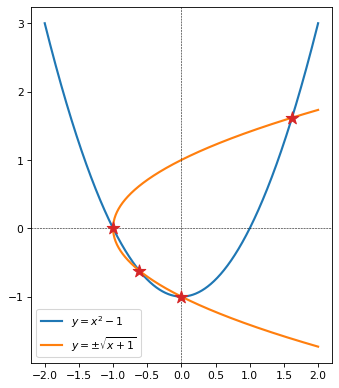
To find roots of our system using pytensor, we first have to symbolically set it up.
Currently, all variables need to be provided in a single vector. So we first make a vector (called variables) of length 2, then unpack it into x and y. I use fancy python double-assignment to do this.
x and y are then used to type in our equations. Like scipy, we need to rewrite the system so that the right-hand size is always zero. In this case we already had that, but in general you will need to keep this in mind.
x, y = variables = pt.tensor('variables', shape=(2, ))
eq_1 = x ** 2 - y - 1
eq_2 = x - y ** 2 + 1
To make a compute graph with a root finder, use pt.optimize.root. The function expects:
A vector of equations to solve,
equationsA vector of variables with respect to which the equations will be solved,
variablesConfiguration arguments, like
method,jacandoptimizer_kwargs, which are forwarded toscipy.optimize.root.
solution, success = pt.optimize.root(equations=pt.stack([eq_1, eq_2]),
variables=variables,
method='hybr',
optimizer_kwargs={'tol':1e-8})
Looking at the graph for the solution, we can see that the outer function takes variables as input and returns the first output of RootOp (the solution).
It also has an inner graph with two outputs. The first is a MakeVector (this is pt.stack), combining eq1 and eq2. So the first inner graph simply computes the equations we provided. The second graph is a Scan – this is the \(2\times2\) Jacobian matrix of the system of the system:
Pytensor happens to compute this matrix using a Scan, so that’s why one appears here.
So notice that we don’t have to compute the Jacobian for this ourselves – it’s automatically by pytensor! Also pytensor can see all these inner functions and optimize across them.
solution.dprint()
RootOp(method=hybr, jac=True).0 [id A]
└─ variables [id B]
Inner graphs:
RootOp(method=hybr, jac=True) [id A]
← MakeVector{dtype='float64'} [id C]
├─ Sub [id D]
│ ├─ Sub [id E]
│ │ ├─ Pow [id F]
│ │ │ ├─ Subtensor{i} [id G]
│ │ │ │ ├─ variables [id H]
│ │ │ │ └─ 0 [id I]
│ │ │ └─ 2 [id J]
│ │ └─ Subtensor{i} [id K]
│ │ ├─ variables [id H]
│ │ └─ 1 [id L]
│ └─ 1 [id M]
└─ Add [id N]
├─ Sub [id O]
│ ├─ Subtensor{i} [id G]
│ │ └─ ···
│ └─ Pow [id P]
│ ├─ Subtensor{i} [id K]
│ │ └─ ···
│ └─ 2 [id Q]
└─ 1 [id R]
← Add [id S]
├─ Blockwise{IncSubtensor{i}, (i00),(),()->(o00)} [id T]
│ ├─ ExpandDims{axis=0} [id U]
│ │ └─ Second [id V]
│ │ ├─ variables [id H]
│ │ └─ ExpandDims{axis=0} [id W]
│ │ └─ 0.0 [id X]
│ ├─ Add [id Y]
│ │ ├─ Mul [id Z]
│ │ │ ├─ Mul [id BA]
│ │ │ │ ├─ Subtensor{:, i} [id BB]
│ │ │ │ │ ├─ Eye{dtype='float64'} [id BC]
│ │ │ │ │ │ ├─ Subtensor{i} [id BD]
│ │ │ │ │ │ │ ├─ Shape [id BE]
│ │ │ │ │ │ │ │ └─ MakeVector{dtype='float64'} [id C]
│ │ │ │ │ │ │ │ └─ ···
│ │ │ │ │ │ │ └─ 0 [id BF]
│ │ │ │ │ │ ├─ Subtensor{i} [id BD]
│ │ │ │ │ │ │ └─ ···
│ │ │ │ │ │ └─ 0 [id BG]
│ │ │ │ │ └─ 0 [id BH]
│ │ │ │ └─ ExpandDims{axis=0} [id BI]
│ │ │ │ └─ 2 [id J]
│ │ │ └─ ExpandDims{axis=0} [id BJ]
│ │ │ └─ Pow [id BK]
│ │ │ ├─ Subtensor{i} [id BL]
│ │ │ │ ├─ variables [id H]
│ │ │ │ └─ 0 [id I]
│ │ │ └─ Sub [id BM]
│ │ │ ├─ 2 [id J]
│ │ │ └─ 1 [id BN]
│ │ └─ Subtensor{:, i} [id BO]
│ │ ├─ Eye{dtype='float64'} [id BC]
│ │ │ └─ ···
│ │ └─ 1 [id BP]
│ └─ ExpandDims{axis=0} [id BQ]
│ └─ TensorFromScalar [id BR]
│ └─ 0 [id I]
└─ Blockwise{IncSubtensor{i}, (i00),(),()->(o00)} [id BS]
├─ ExpandDims{axis=0} [id BT]
│ └─ Second [id BU]
│ ├─ variables [id H]
│ └─ ExpandDims{axis=0} [id BV]
│ └─ 0.0 [id BW]
├─ Add [id BX]
│ ├─ Neg [id BY]
│ │ └─ Subtensor{:, i} [id BB]
│ │ └─ ···
│ └─ Mul [id BZ]
│ ├─ Mul [id CA]
│ │ ├─ Neg [id CB]
│ │ │ └─ Subtensor{:, i} [id BO]
│ │ │ └─ ···
│ │ └─ ExpandDims{axis=0} [id CC]
│ │ └─ 2 [id Q]
│ └─ ExpandDims{axis=0} [id CD]
│ └─ Pow [id CE]
│ ├─ Subtensor{i} [id CF]
│ │ ├─ variables [id H]
│ │ └─ 1 [id L]
│ └─ Sub [id CG]
│ ├─ 2 [id Q]
│ └─ 1 [id CH]
└─ ExpandDims{axis=0} [id CI]
└─ TensorFromScalar [id CJ]
└─ 1 [id L]
<ipykernel.iostream.OutStream at 0x7f9c8dd689a0>
Since we’re not doing anything with the outputs, we’re ready to compile a function. We don’t have any parameters, so we just pass in the variables – which are treated as the inital values – and pass back the solution and success flag.
fn = pytensor.function([variables],
[solution, success])
Looking at the final graph, we see how both outputs – the system of equations and the jacobian – become simplified.
fn.dprint(print_shape=True)
RootOp(method=hybr, jac=True).0 [id A] shape=(2,) 0
└─ variables [id B] shape=(2,)
RootOp(method=hybr, jac=True).1 [id A] shape=() 'success' 0
└─ ···
Inner graphs:
RootOp(method=hybr, jac=True) [id A]
← MakeVector{dtype='float64'} [id C] shape=(2,)
├─ Composite{((-1.0 + sqr(i0)) - i1)} [id D] shape=()
│ ├─ Subtensor{i} [id E] shape=()
│ │ ├─ variables [id F] shape=(2,)
│ │ └─ 0 [id G] shape=()
│ └─ Subtensor{i} [id H] shape=()
│ ├─ variables [id F] shape=(2,)
│ └─ 1 [id I] shape=()
└─ Composite{((1.0 + i1) - sqr(i0))} [id J] shape=()
├─ Subtensor{i} [id H] shape=()
│ └─ ···
└─ Subtensor{i} [id E] shape=()
└─ ···
← IncSubtensor{:, i} [id K] shape=(2, 2)
├─ IncSubtensor{:, i} [id L] shape=(2, 2)
│ ├─ Alloc [id M] shape=(2, 2)
│ │ ├─ [[0.]] [id N] shape=(1, 1)
│ │ ├─ 2 [id O] shape=()
│ │ └─ 2 [id P] shape=()
│ ├─ Composite{((i0 * i1) + i2)} [id Q] shape=(2,)
│ │ ├─ [2. 0.] [id R] shape=(2,)
│ │ ├─ ExpandDims{axis=0} [id S] shape=(1,)
│ │ │ └─ Subtensor{i} [id E] shape=()
│ │ │ └─ ···
│ │ └─ [0. 1.] [id T] shape=(2,)
│ └─ 0 [id G] shape=()
├─ Composite{(i2 + (i0 * i1))} [id U] shape=(2,)
│ ├─ [-0. -2.] [id V] shape=(2,)
│ ├─ ExpandDims{axis=0} [id W] shape=(1,)
│ │ └─ Subtensor{i} [id H] shape=()
│ │ └─ ···
│ └─ [-1. -0.] [id X] shape=(2,)
└─ 1 [id I] shape=()
Composite{((-1.0 + sqr(i0)) - i1)} [id D]
← sub [id Y] shape=() 'o0'
├─ add [id Z] shape=()
│ ├─ -1.0 [id BA] shape=()
│ └─ sqr [id BB] shape=()
│ └─ i0 [id BC] shape=()
└─ i1 [id BD] shape=()
Composite{((1.0 + i1) - sqr(i0))} [id J]
← sub [id BE] shape=() 'o0'
├─ add [id BF] shape=()
│ ├─ 1.0 [id BG] shape=()
│ └─ i1 [id BH] shape=()
└─ sqr [id BI] shape=()
└─ i0 [id BJ] shape=()
Composite{((i0 * i1) + i2)} [id Q]
← add [id BK] shape=() 'o0'
├─ mul [id BL] shape=()
│ ├─ i0 [id BM] shape=()
│ └─ i1 [id BN] shape=()
└─ i2 [id BO] shape=()
Composite{(i2 + (i0 * i1))} [id U]
← add [id BP] shape=() 'o0'
├─ i2 [id BQ] shape=()
└─ mul [id BR] shape=()
├─ i0 [id BS] shape=()
└─ i1 [id BT] shape=()
<ipykernel.iostream.OutStream at 0x7f9c8dd689a0>
Checking some points. We see that starting at \(0, 0\), we converge to \(x, y = \frac{-1 - \sqrt{5}}{2} \approx -0.618\).
fn([0., 0.])
[array([-0.61803399, -0.61803399]), np.True_]
Starting at \(1,1\), we converge to \(x, y = \frac{-1 + \sqrt{5}}{2} \approx 1.618\)
fn([1., 1.])
[array([1.61803399, 1.61803399]), np.True_]
Starting at \(-1, 1\), we converge to \(x=-1, y=0\)
fn([-1, 1])
[array([-1.00000000e+00, -1.26918883e-12]), np.True_]
And starting at \(1, -1\), we converge to \(x=0, y=-1\)
fn([1, -1])
[array([-1.2693032e-12, -1.0000000e+00]), np.True_]
Graph manipulation#
Since the root Op is fully symbolic, we can manipulate its graph as much as we like.
For example, we can vectorize it. This will allow us to test many points at the same time. To do this, we create a new variable with a batch dimension, then rewrite the graph to work out the resulting dimensions.
from pytensor.graph.replace import vectorize_graph
variables_grid = pt.tensor('x', shape=(None, 2))
grid_of_solutions = vectorize_graph([solution, success],
{variables:variables_grid})
Compile the new, vectorized function
fn_vec = pytensor.function([variables_grid],
grid_of_solutions)
Now that we’re vectorized, the input will be a 2d array of values, with the first column representing x, and the second column y.
To quickly get a bunch of pairs of values, we can use np.meshgrid.
x_values = np.linspace(-2, 2, 30)
xx, yy = np.meshgrid(x_values, x_values)
grid_values = np.c_[xx.ravel(), yy.ravel()]
solution_grid, success_grid = fn_vec(grid_values)
unique_solutions = np.unique(np.round(solution_grid, 3), axis=0)
solution_ids = {tuple(v.tolist()): k for k, v in enumerate(unique_solutions)}
Across all the solution, we found only the four roots we expected, which is great!
unique_solutions
array([[-1. , -0. ],
[-0.618, -0.618],
[ 0. , -1. ],
[ 1.618, 1.618]])
We can make a nice plot to see that roots roughly correspond to the four graph quadrents. But there are some exceptions, especially near the origin.
fig, ax = plt.subplots(subplot_kw={'aspect':'equal'}, figsize=(14, 6))
x_plot = np.linspace(-2, 2, 1000)
ax.plot(x_plot, x_plot ** 2 - 1, color='tab:blue', lw=2)
with np.errstate(all='ignore'):
ax.plot(x_plot, np.sqrt(x_plot + 1), color='tab:orange', lw=2)
ax.plot(x_plot, -np.sqrt(x_plot + 1), color='tab:orange', lw=2)
ax.axhline(0, ls='--', c='k', lw=0.5)
ax.axvline(0, ls='--', c='k', lw=0.5)
colors = ['tab:blue', 'tab:orange', 'tab:green', 'tab:purple']
rounded_solutions = np.round(solution_grid, 3)
for root, color in zip(unique_solutions, colors):
subset_idx = (rounded_solutions == root).all(axis=1)
subset = grid_values[subset_idx]
ax.scatter(*subset.T, facecolor=color, edgecolor='none', alpha=0.25, label=fr'$({root[0]}, {root[1]})$')
ax.scatter(*root, color='tab:red', zorder=1000)
for x0 in subset:
ax.annotate(xy=root, xytext=x0, text='', arrowprops={'arrowstyle':'->', 'linewidth':0.5, 'alpha':0.5})
fig.legend(ncol=1, bbox_to_anchor=(0.65, 0.5), loc='center left')
plt.show()
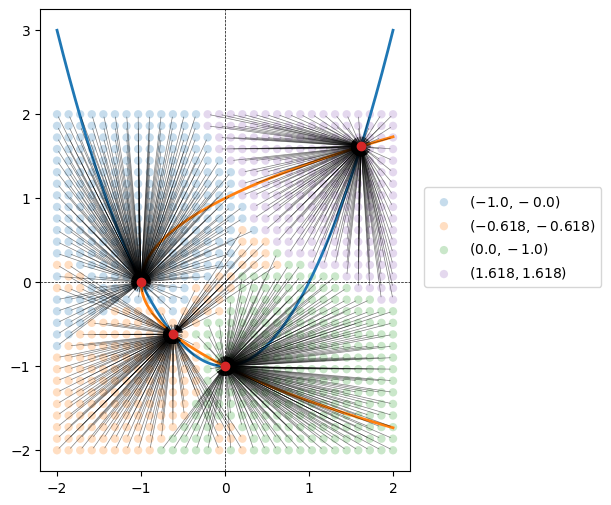
A function with parameters#
Our first function was really simple. More commonly, a function of interest will have both variables and parameters.
To keep things simple, we can add a coefficent in front of every term in our system of two equations:
Although this still looks quite simple, we no longer have a general analytic solution! If we are faced with a parameterized function like like “in the wild”, we have no choice but to resort to numerical methods.
To get back to what we’ve been looking at, we can set: \(a=1\), \(b=-1\), \(c=-1\), \(d=1\), \(e=-1\), \(f=1\)
x, y = variables = pt.tensor('variables', shape=(2, ))
a, b, c, d, e, f = pt.scalars('a b c d e f'.split())
eq_1 = a * x ** 2 + b * y + c
eq_2 = d * x + e * y ** 2 + f
Notice that we don’t change the call to optimize.root at all!
solution, success = pt.optimize.root(equations=pt.stack([eq_1, eq_2]),
variables=variables,
method='hybr',
optimizer_kwargs={'tol':1e-8})
Unlike scipy.optimize.root, pytensor is going to automatically figure out what additional arguments are required. By knowing equations and variables, pytensor analyses the implied subgraph, and collects all other unknowns as args.
We can see now that the inputs to the RootOp are variables, then all the parameters. Otherwise, the graph is unchanged. As a user, though, you will never interact with this inner function! You just pass the parameter values and pytensor will figure out the rest.
solution.dprint()
RootOp(method=hybr, jac=True).0 [id A]
├─ variables [id B]
├─ f [id C]
├─ e [id D]
├─ d [id E]
├─ c [id F]
├─ b [id G]
└─ a [id H]
Inner graphs:
RootOp(method=hybr, jac=True) [id A]
← MakeVector{dtype='float64'} [id I]
├─ Add [id J]
│ ├─ Add [id K]
│ │ ├─ Mul [id L]
│ │ │ ├─ a [id M]
│ │ │ └─ Pow [id N]
│ │ │ ├─ Subtensor{i} [id O]
│ │ │ │ ├─ variables [id P]
│ │ │ │ └─ 0 [id Q]
│ │ │ └─ 2 [id R]
│ │ └─ Mul [id S]
│ │ ├─ b [id T]
│ │ └─ Subtensor{i} [id U]
│ │ ├─ variables [id P]
│ │ └─ 1 [id V]
│ └─ c [id W]
└─ Add [id X]
├─ Add [id Y]
│ ├─ Mul [id Z]
│ │ ├─ d [id BA]
│ │ └─ Subtensor{i} [id O]
│ │ └─ ···
│ └─ Mul [id BB]
│ ├─ e [id BC]
│ └─ Pow [id BD]
│ ├─ Subtensor{i} [id U]
│ │ └─ ···
│ └─ 2 [id BE]
└─ f [id BF]
← Add [id BG]
├─ Blockwise{IncSubtensor{i}, (i00),(),()->(o00)} [id BH]
│ ├─ ExpandDims{axis=0} [id BI]
│ │ └─ Second [id BJ]
│ │ ├─ variables [id P]
│ │ └─ ExpandDims{axis=0} [id BK]
│ │ └─ 0.0 [id BL]
│ ├─ Add [id BM]
│ │ ├─ Mul [id BN]
│ │ │ ├─ Mul [id BO]
│ │ │ │ ├─ Mul [id BP]
│ │ │ │ │ ├─ Subtensor{:, i} [id BQ]
│ │ │ │ │ │ ├─ Eye{dtype='float64'} [id BR]
│ │ │ │ │ │ │ ├─ Subtensor{i} [id BS]
│ │ │ │ │ │ │ │ ├─ Shape [id BT]
│ │ │ │ │ │ │ │ │ └─ MakeVector{dtype='float64'} [id I]
│ │ │ │ │ │ │ │ │ └─ ···
│ │ │ │ │ │ │ │ └─ 0 [id BU]
│ │ │ │ │ │ │ ├─ Subtensor{i} [id BS]
│ │ │ │ │ │ │ │ └─ ···
│ │ │ │ │ │ │ └─ 0 [id BV]
│ │ │ │ │ │ └─ 0 [id BW]
│ │ │ │ │ └─ ExpandDims{axis=0} [id BX]
│ │ │ │ │ └─ a [id M]
│ │ │ │ └─ ExpandDims{axis=0} [id BY]
│ │ │ │ └─ 2 [id R]
│ │ │ └─ ExpandDims{axis=0} [id BZ]
│ │ │ └─ Pow [id CA]
│ │ │ ├─ Subtensor{i} [id CB]
│ │ │ │ ├─ variables [id P]
│ │ │ │ └─ 0 [id Q]
│ │ │ └─ Sub [id CC]
│ │ │ ├─ 2 [id R]
│ │ │ └─ 1 [id CD]
│ │ └─ Mul [id CE]
│ │ ├─ Subtensor{:, i} [id CF]
│ │ │ ├─ Eye{dtype='float64'} [id BR]
│ │ │ │ └─ ···
│ │ │ └─ 1 [id CG]
│ │ └─ ExpandDims{axis=0} [id CH]
│ │ └─ d [id BA]
│ └─ ExpandDims{axis=0} [id CI]
│ └─ TensorFromScalar [id CJ]
│ └─ 0 [id Q]
└─ Blockwise{IncSubtensor{i}, (i00),(),()->(o00)} [id CK]
├─ ExpandDims{axis=0} [id CL]
│ └─ Second [id CM]
│ ├─ variables [id P]
│ └─ ExpandDims{axis=0} [id CN]
│ └─ 0.0 [id CO]
├─ Add [id CP]
│ ├─ Mul [id CQ]
│ │ ├─ Subtensor{:, i} [id BQ]
│ │ │ └─ ···
│ │ └─ ExpandDims{axis=0} [id CR]
│ │ └─ b [id T]
│ └─ Mul [id CS]
│ ├─ Mul [id CT]
│ │ ├─ Mul [id CU]
│ │ │ ├─ Subtensor{:, i} [id CF]
│ │ │ │ └─ ···
│ │ │ └─ ExpandDims{axis=0} [id CV]
│ │ │ └─ e [id BC]
│ │ └─ ExpandDims{axis=0} [id CW]
│ │ └─ 2 [id BE]
│ └─ ExpandDims{axis=0} [id CX]
│ └─ Pow [id CY]
│ ├─ Subtensor{i} [id CZ]
│ │ ├─ variables [id P]
│ │ └─ 1 [id V]
│ └─ Sub [id DA]
│ ├─ 2 [id BE]
│ └─ 1 [id DB]
└─ ExpandDims{axis=0} [id DC]
└─ TensorFromScalar [id DD]
└─ 1 [id V]
<ipykernel.iostream.OutStream at 0x7f9c8dd689a0>
fn = pytensor.function([variables, a, b, c, d, e, f],
[solution, success])
arg_inputs = {'a': 1, 'b': -1, 'c': -1, 'd': 1, 'e': -1, 'f': 1}
We can double-check that we still get the same answers:
fn([0., 0.], **arg_inputs)
[array([-0.61803399, -0.61803399]), np.True_]
fn([1., 1.], **arg_inputs)
[array([1.61803399, 1.61803399]), np.True_]
Gradients#
Since root is symbolic Op, we can backprop through it. To do this, we use the implicit value theorem. We have a function \(f(x, \theta)\), where \(x\) are the variables, and \(\theta\) are the parameters. There’s some optimal \(x^\star\) that depends on \(\theta\) such, such that \(f(x^\star(\theta), \theta) = 0\)
If we take \(\frac{\partial}{\partial \theta} f(x^\star(\theta), \theta)\) and use the chain rule, we get:
The zero arises because, by definition, \(f(x^\star(\theta), \theta) = 0\). All three of the terms in this expression are matrices, and we know 2 of them. As a result, we can directly solve for the unknown quantity of interest, \(\frac{\partial x^\star(\theta)}{\partial \theta}\):
So we just need the jacobian of the objective function with respect to the variables \(x\) and parameters \(\theta\), all evaluated at the optimal point \(x^\star\).
dx_dtheta = pt.grad(solution[0], [a, b, c, d, e, f])
dy_dtheta = pt.grad(solution[1], [a, b, c, d, e, f])
d_theta_vec = pt.stack([dx_dtheta, dy_dtheta], axis=-1)
f_d_theta = pytensor.function([variables, a, b, c, d, e, f], d_theta_vec)
These values show, evidently, the effect of a nudge to one of the 6 parameteres (on the rows) on the value of the variables \(x\) and \(y\) (on the columns).
f_d_theta([0., 0.], **arg_inputs)
array([[ 0.89442719, -0.7236068 ],
[-1.4472136 , 1.17082039],
[ 2.34164079, -1.89442719],
[-1.17082039, 1.4472136 ],
[ 0.7236068 , -0.89442719],
[ 1.89442719, -2.34164079]])
Note that this is unique to the root associated with the \((0, 0)\) point. If we shift the point \((0, 0)\) slightly, but still in a zone that converges to the \((-0.618, -0.618)\) root, we will get the same gradients
f_d_theta([-1.0, -1.0], **arg_inputs)
array([[ 0.89442719, -0.7236068 ],
[-1.4472136 , 1.17082039],
[ 2.34164079, -1.89442719],
[-1.17082039, 1.4472136 ],
[ 0.7236068 , -0.89442719],
[ 1.89442719, -2.34164079]])
On the other hand, if we evaluate at a different root, for example the \((1.618, 1.618)\) root, we will have different gradients.
f_d_theta([0.8, 0.8], **arg_inputs)
array([[-0.89442719, -0.2763932 ],
[-0.5527864 , -0.17082039],
[-0.34164079, -0.10557281],
[ 0.17082039, 0.5527864 ],
[ 0.2763932 , 0.89442719],
[ 0.10557281, 0.34164079]])
Using roots for downstream computation#
Often, there are quantities of interest downstream of an optimization problem that researchers are interested in studying.
One such example comes from labor economics. The McCall Search Model is a relatively simple model of how people look for jobs. Every day, an unemployed worker wakes up and gets a job offer. The wage of the job on offer that day (at time \(t\)) is drawn from a known distribution \(w_t \sim Q(\cdot)\). Offers are IID across time.
The workers can either:
Accept the job and work it for the rest of his life, earning \(w_t\) forever, or;
Reject the job, and wait for another one to come along. In this case, he earns unemployment benefits \(c\), and gets to see another offer tomorrow.
The agent’s objective is to maxmize expected discounted utility over his lifetime. We assume he discounts at rate \(\beta\), such that:
Where \(y_t\) is the the income the worker will earn at period \(t\), either \(c\) or \(w_\tau\), depending on his choices up to that point (\(\tau\) is the period in which he accepted the wage, if he did).
Interested readers can check the quantecon link for details. For our purposes here, it suffices to say that this is a dynamic program involving a search for an optimal value function. A value function maps states of the world to expected utility, allowing an agent to evaluate actions. With some manipulation, it can be shown that the worker in this model has the following value function:
Where \(w\) is a vector of all known wages (or at least some kind of sampling over the support of the wage distribution, \(\mathbb{W}\)). So \(v\), \(w\) and \(q(w)\) are all vectors. By \(v^\star(w)\), we mean the value of a wage offer \(w\) under the optimal value function, \(v^\star\).
Because of the special properties of this value function, it can be shown that it defines a fixed-point operator \(T\). Starting an arbitrary vector \(v_0\), iteratively applying the following function:
Will eventaully converge to the optimal value function, no matter what \(v_0\) is chosen.
Where’s the root?#
What quantecon presents is value function iteration. We can, however, just jump to the end by interpreting the definition of the fixed-point operator \(Tv\) as a system of non-linear equations. In particular, we just require some vector \(v\) such that:
Such a vector will contain all the roots of this equation. We can find the answer directly, without using value-function iteration.
Where do wages come from?#
This is a free choice in the model. Following QuantEcon, we will assume they follow a Beta-Binomial Distribution. Pytensor implements this random variable and can draw samples from it, but it doesn’t give us the PMF out of the box. We have to write it ourselves, using the definition from Wikipedia:
Where \(B(x, y)\) is the Beta function.
For numerical stability, we will actually compute the logpmf, then exp it.
from pytensor.tensor.special import betaln
n, a, b = pt.scalars('n a b'.split())
w_min, w_max = pt.scalars('w_min w_max'.split())
w_support = pt.linspace(w_min, w_max, n+1)
k = pt.floor(w_support)
ln_n_choose_k = -pt.log(n + 1) - betaln(n - k + 1, k + 1)
q_probs = pt.exp(ln_n_choose_k + betaln(k + a, n - k + b) - betaln(a, b))
dist_args = [n, a, b, w_min, w_max]
f = pytensor.function(dist_args, [w_support, q_probs])
dist_params = {'n':50, 'a':200, 'b':100, 'w_min':10, 'w_max':60}
fig, ax = plt.subplots(figsize=(14, 4))
ax.bar(*f(**dist_params))
ax.set(title='Wage Distribution', xlabel='Wage', ylabel='P(Wage)')
ax.grid(ls='--', lw=0.5)
[spine.set_visible(False) for spine in ax.spines.values()]
plt.show()
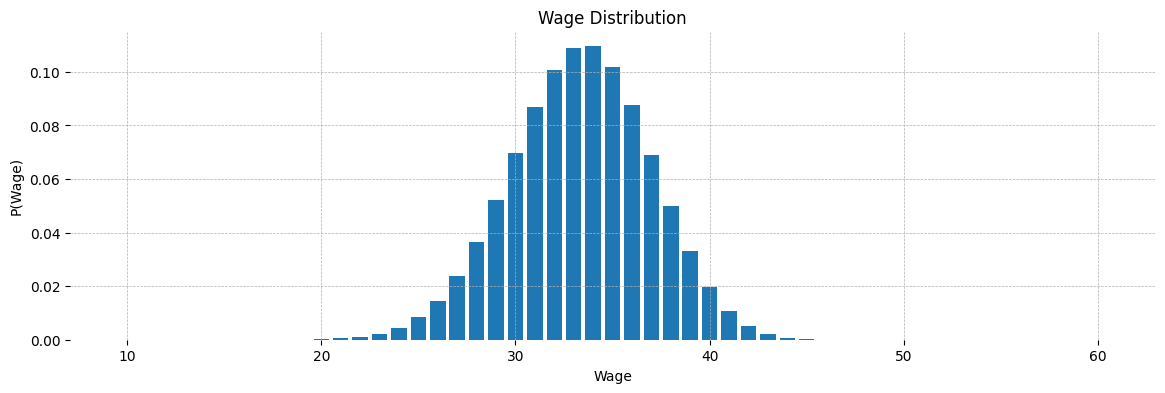
Setting up the model#
c = pt.dscalar('c') # Unemployment benefit
β = pt.dscalar('β') # Discount rate
# initial value function guess
v0 = pt.dvector('v0')
# Fixed-point operator
T = pt.maximum(w_support / (1 - β), c + β * pt.dot(v0, q_probs))
v_star, success = pt.optimize.root(equations=T - v0,
variables=v0,
method='hybr')
fn = pytensor.function([v0, c, β, *dist_args],
[w_support, v_star, success])
Solving for the value function#
c_value = 25
beta_value = 0.99
v0_value = np.zeros(dist_params['n'] + 1)
w_values, v_star_val, success_flag = fn(v0_value, c_value, beta_value, **dist_params)
This plot shows the optimal value function. Below the reservation wage (which appears to be around 38), the worker will not accept a job, and gets constant utility from being on unemployment. After the reservation wage, his lifetime utility is increasing linearly in his wage level.
fig, ax = plt.subplots(figsize=(14, 4), dpi=144)
ax.plot(w_values, v_star_val)
ax.set(title='Lifetime Value of Wages', xlabel='Wage', ylabel='Value Function')
ax.grid(ls='--', lw=0.5)
[spine.set_visible(False) for spine in ax.spines.values()]
plt.show()
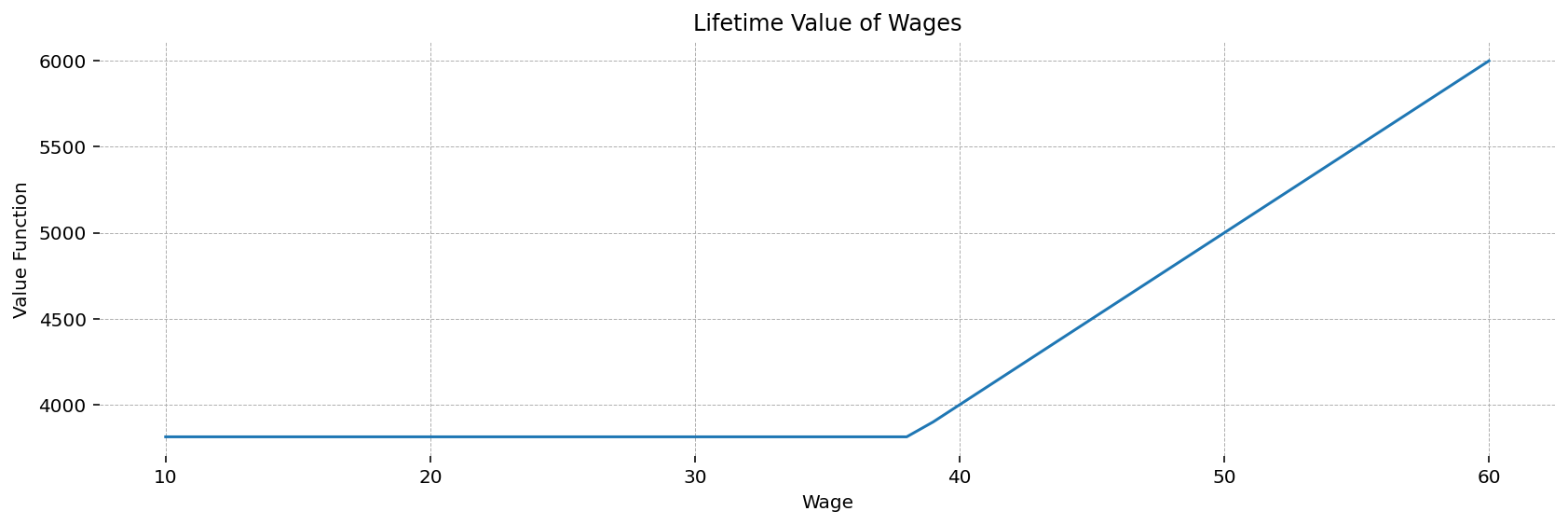
Studying the reservation wage#
While the shape of the value function is interesting per se, it is not the primary object of interest in this study. Instead, we are interested in the reservation wage – the minimum wage at which the worker will willingly choose to exit unemployment and join the workforce.
This wage can be computed as:
w_bar = (1 - β) * (c + β * pt.dot(v_star, q_probs))
# We want to study the impact of change in unemployment and patience on the reserve wage
w_grads = pt.grad(w_bar, [c, β])
---------------------------------------------------------------------------
TypeError Traceback (most recent call last)
Cell In[36], line 4
1 w_bar = (1 - β) * (c + β * pt.dot(v_star, q_probs))
3 # We want to study the impact of change in unemployment and patience on the reserve wage
----> 4 w_grads = pt.grad(w_bar, [c, β])
File ~/Documents/pytensor/pytensor/gradient.py:747, in grad(cost, wrt, consider_constant, disconnected_inputs, add_names, known_grads, return_disconnected, null_gradients)
744 if hasattr(g.type, "dtype"):
745 assert g.type.dtype in pytensor.tensor.type.float_dtypes
--> 747 _rval: Sequence[Variable] = _populate_grad_dict(
748 var_to_app_to_idx, grad_dict, _wrt, cost_name
749 )
751 rval: MutableSequence[Variable | None] = list(_rval)
753 for i in range(len(_rval)):
File ~/Documents/pytensor/pytensor/gradient.py:1541, in _populate_grad_dict(var_to_app_to_idx, grad_dict, wrt, cost_name)
1538 # end if cache miss
1539 return grad_dict[var]
-> 1541 rval = [access_grad_cache(elem) for elem in wrt]
1543 return rval
File ~/Documents/pytensor/pytensor/gradient.py:1496, in _populate_grad_dict.<locals>.access_grad_cache(var)
1494 for node in node_to_idx:
1495 for idx in node_to_idx[node]:
-> 1496 term = access_term_cache(node)[idx]
1498 if not isinstance(term, Variable):
1499 raise TypeError(
1500 f"{node.op}.grad returned {type(term)}, expected"
1501 " Variable instance."
1502 )
File ~/Documents/pytensor/pytensor/gradient.py:1326, in _populate_grad_dict.<locals>.access_term_cache(node)
1318 if o_shape != g_shape:
1319 raise ValueError(
1320 "Got a gradient of shape "
1321 + str(o_shape)
1322 + " on an output of shape "
1323 + str(g_shape)
1324 )
-> 1326 input_grads = node.op.L_op(inputs, node.outputs, new_output_grads)
1328 if input_grads is None:
1329 raise TypeError(
1330 f"{node.op}.grad returned NoneType, expected iterable."
1331 )
File ~/Documents/pytensor/pytensor/tensor/optimize.py:915, in RootOp.L_op(self, inputs, outputs, output_grads)
906 df_dx = (
907 jacobian(inner_fx, inner_x, vectorize=True)
908 if not self.jac
909 else self.fgraph.outputs[1]
910 )
911 df_dtheta_columns = jacobian(
912 inner_fx, inner_args, disconnected_inputs="ignore", vectorize=True
913 )
--> 915 grad_wrt_args = implict_optimization_grads(
916 df_dx=df_dx,
917 df_dtheta_columns=df_dtheta_columns,
918 args=args,
919 x_star=x_star,
920 output_grad=output_grad,
921 fgraph=self.fgraph,
922 )
924 return [zeros_like(x), *grad_wrt_args]
File ~/Documents/pytensor/pytensor/tensor/optimize.py:333, in implict_optimization_grads(df_dx, df_dtheta_columns, args, x_star, output_grad, fgraph)
290 r"""
291 Compute gradients of an optimization problem with respect to its parameters.
292
(...)
329 The function graph that contains the inputs and outputs of the optimization problem.
330 """
331 df_dx = cast(TensorVariable, df_dx)
--> 333 df_dtheta = concatenate(
334 [
335 atleast_2d(jac_col, left=False)
336 for jac_col in cast(list[TensorVariable], df_dtheta_columns)
337 ],
338 axis=-1,
339 )
341 replace = dict(zip(fgraph.inputs, (x_star, *args), strict=True))
343 df_dx_star, df_dtheta_star = cast(
344 list[TensorVariable],
345 graph_replace([atleast_2d(df_dx), df_dtheta], replace=replace),
346 )
File ~/Documents/pytensor/pytensor/tensor/basic.py:2991, in concatenate(tensor_list, axis)
2984 if not isinstance(tensor_list, tuple | list):
2985 raise TypeError(
2986 "The 'tensors' argument must be either a tuple "
2987 "or a list, make sure you did not forget () or [] around "
2988 "arguments of concatenate.",
2989 tensor_list,
2990 )
-> 2991 return join(axis, *tensor_list)
File ~/Documents/pytensor/pytensor/tensor/basic.py:2805, in join(axis, *tensors_list)
2803 return tensors_list[0]
2804 else:
-> 2805 return _join(axis, *tensors_list)
File ~/Documents/pytensor/pytensor/graph/op.py:293, in Op.__call__(self, name, return_list, *inputs, **kwargs)
249 def __call__(
250 self, *inputs: Any, name=None, return_list=False, **kwargs
251 ) -> Variable | list[Variable]:
252 r"""Construct an `Apply` node using :meth:`Op.make_node` and return its outputs.
253
254 This method is just a wrapper around :meth:`Op.make_node`.
(...)
291
292 """
--> 293 node = self.make_node(*inputs, **kwargs)
294 if name is not None:
295 if len(node.outputs) == 1:
File ~/Documents/pytensor/pytensor/tensor/basic.py:2498, in Join.make_node(self, axis, *tensors)
2495 ndim = tensors[0].type.ndim
2497 if not builtins.all(x.ndim == ndim for x in tensors):
-> 2498 raise TypeError(
2499 "Only tensors with the same number of dimensions can be joined. "
2500 f"Input ndims were: {[x.ndim for x in tensors]}"
2501 )
2503 try:
2504 static_axis = int(get_scalar_constant_value(axis))
TypeError: Only tensors with the same number of dimensions can be joined. Input ndims were: [3, 2, 2, 2]
fn_2 = pytensor.function([v0, c, β, *dist_args],
[success, w_bar, *w_grads],
on_unused_input='ignore')
---------------------------------------------------------------------------
NameError Traceback (most recent call last)
Cell In[38], line 2
1 fn_2 = pytensor.function([v0, c, β, *dist_args],
----> 2 [success, w_bar, *w_grads],
3 on_unused_input='ignore')
NameError: name 'w_grads' is not defined
success_flag, reservation_wage, dw_dc, dw_dβ = fn_2(v0_value, c_value, beta_value, **dist_params)
print(f'Reservation wage at c={c_value}, β={beta_value}: {reservation_wage.item()}')
print(f'Change in reservation wage given unit change in c: {dw_dc}')
print(f'Change in reservation wage given 1% change in β: {dw_dβ / 100}')
---------------------------------------------------------------------------
NameError Traceback (most recent call last)
Cell In[39], line 1
----> 1 success_flag, reservation_wage, dw_dc, dw_dβ = fn_2(v0_value, c_value, beta_value, **dist_params)
2 print(f'Reservation wage at c={c_value}, β={beta_value}: {reservation_wage.item()}')
3 print(f'Change in reservation wage given unit change in c: {dw_dc}')
NameError: name 'fn_2' is not defined
We likely want to study the effect of many pairs of c and \(\beta\), so we vectorize the function
c_grid = pt.dmatrix('c_grid')
β_grid = pt.dmatrix('β_grid')
w_bar_grid, *w_grad_grid = vectorize_graph([w_bar, *w_grads], {β:β_grid, c:c_grid})
fn_grid = pytensor.function([v0, c_grid, β_grid, *dist_args],
[w_bar_grid, *w_grad_grid],
on_unused_input='ignore')
---------------------------------------------------------------------------
NameError Traceback (most recent call last)
Cell In[40], line 4
1 c_grid = pt.dmatrix('c_grid')
2 β_grid = pt.dmatrix('β_grid')
----> 4 w_bar_grid, *w_grad_grid = vectorize_graph([w_bar, *w_grads], {β:β_grid, c:c_grid})
6 fn_grid = pytensor.function([v0, c_grid, β_grid, *dist_args],
7 [w_bar_grid, *w_grad_grid],
8 on_unused_input='ignore')
NameError: name 'w_grads' is not defined
c_values = np.linspace(10, 50, 30)
β_values = np.linspace(0.1, 0.99, 30)
cc, bb = np.meshgrid(c_values, β_values)
# Use the answer we already found as starting value to try to speed up convergence
w_bar_grid_vals, *w_grad_grid_vals = fn_grid(v_star_val, cc, bb,
**dist_params)
This next cell reproduces the final plot of the quantecon lecture
fig, ax = plt.subplots(figsize=(8, 5))
cs1 = ax.contourf(cc, bb, w_bar_grid_vals, alpha=0.75)
ctr1 = ax.contour(cc, bb, w_bar_grid_vals, colors='k', linestyles='dashed', )
ax.clabel(ctr1, inline=1, fontsize=13, colors='k')
plt.colorbar(cs1, ax=ax)
ax.set_title("reservation wage")
ax.set_xlabel("$c$", fontsize=16)
ax.set_ylabel("$β$", fontsize=16)
ax.ticklabel_format(useOffset=False)
plt.show()
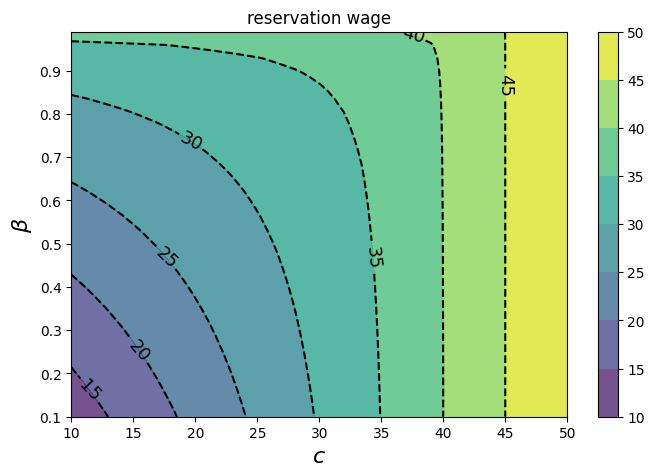
Since we have the gradients, we can also show a vector field of how the reservation wage changes at each point.
From this perspective, we see that the reservation wage increases more when \(c\) is increased by \\(1 than when \)\beta\( is increased by 1\%. The gradients primarily point in the \)c\( direction, except when \)c < 20$.
fig, ax = plt.subplots(figsize=(8, 5))
cc_grad, bb_grad = w_grad_grid_vals
cs1 = ax.contourf(cc, bb, w_bar_grid_vals, alpha=0.75)
ax.quiver(cc, bb, cc_grad, bb_grad / 100)
plt.colorbar(cs1, ax=ax)
ax.set_title("reservation wage")
ax.set_xlabel("$c$", fontsize=16)
ax.set_ylabel("$β$", fontsize=16)
ax.ticklabel_format(useOffset=False)
plt.show()
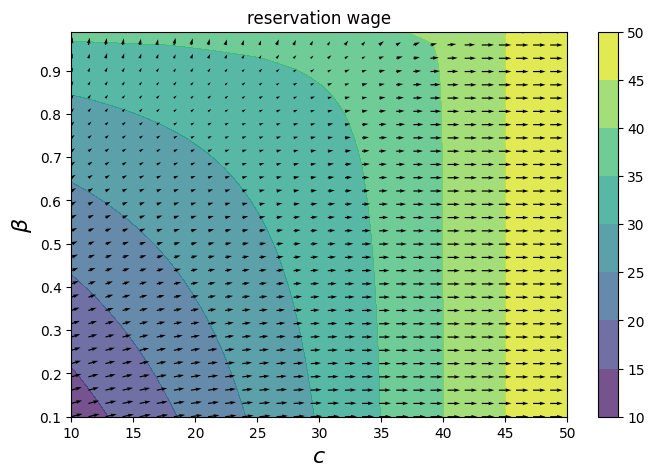
Effect of the wage distribution#
Since our entire problem is symbolic – including the distribution over wage offers – we can also study the effect of a shift in the wage distribution. To do this, we fix \(\beta = 0.99\) and \(c=25\), and instead vectorize \(\alpha\), \(\beta\), and \(n\).
We are interested in the effect of shifts in the moments of the distribution. For a Beta-Binominal, the first two raw moments are:
Where \(p = \frac{\alpha}{\alpha + \beta}\) and \(\rho = \frac{1}{\alpha + \beta + 1}\)
For this analysis, it’s not helpful to have the problem written in terms of \(\alpha\) and \(\beta\) – we’d like to ask questions like “what happens if the mean or variance of the wage distribution changes”?
To do this, we can reparameterize the wage distribution in terms of \(\mu\) and \(\sigma\). Given a fixed \(n\), we simply solve the two equations above for \(\alpha\) and \(\beta\):
We will re-use the graphs we’ve been using so far, merely replacing \(\alpha\) and \(\beta\) by these functions of \(\mu\) and \(\sigma\).
mu, sigma = pt.scalars('mu sigma'.split())
a_fn = mu * (mu ** 2 - mu * n + sigma ** 2) / (-mu ** 2 + mu * n - n * sigma ** 2)
b_fn = (mu - n) * (mu ** 2 - mu * n + sigma ** 2) / (mu ** 2 - mu * n + n * sigma ** 2)
w_bar_2 = pytensor.graph_replace(w_bar, {a: a_fn, b:b_fn})
To drive home what we’ve just done, we can look at what input values w_bar_2 expects. Note that a and b no longer appear! Instead, it looks for mu and sigma.
from pytensor.graph.basic import explicit_graph_inputs
list(explicit_graph_inputs(w_bar_2))
[β, c, v0, n, w_min, w_max, mu, sigma]
We can check that our formulas are right by checking that we can make a “round trip” from the original parameterization of \(a=200\), \(b=100\)
p = a / (a + b)
rho = 1 / (1 + a + b)
mu_val = (p * n).eval({a:200, b:100, n:50})
sigma_val = pt.sqrt(n * p * (1 - p) * (1 + (n - 1) * rho)).eval({a:200, b:100, n:50})
print(f'mu = {mu_val.item():0.3f}')
print(f'sigma = {sigma_val.item():0.3f}')
mu = 33.333
sigma = 3.594
print(f'a = {a_fn.eval({mu:mu_val, sigma:sigma_val, n:50}):0.2f}')
print(f'b = {b_fn.eval({mu:mu_val, sigma:sigma_val, n:50}):0.2f}')
a = 200.00
b = 100.00
We can also plot the distributions we get for different values of \(\mu\) and \(\sigma\)
dist_args = [n, mu, sigma, w_min, w_max]
f = pytensor.function(dist_args, [w_support,
pytensor.graph_replace(q_probs, {a:a_fn, b:b_fn})])
dist_params = {'n':50, 'mu':33.333, 'sigma':3.594, 'w_min':10, 'w_max':60}
fig, ax = plt.subplots(figsize=(14, 4))
ax.bar(*f(**dist_params), alpha=0.75, label='μ=33.3, σ=3.594')
ax.bar(*f(**dist_params | {'mu':40}), alpha=0.75, label='μ=40.0, σ=3.594')
ax.bar(*f(**dist_params | {'sigma': 5.0}), alpha=0.75, label='μ=33.3, σ=5.0')
ax.set(title='Wage Distribution', xlabel='Wage', ylabel='P(Wage)')
ax.legend()
ax.grid(ls='--', lw=0.5)
[spine.set_visible(False) for spine in ax.spines.values()]
plt.show()
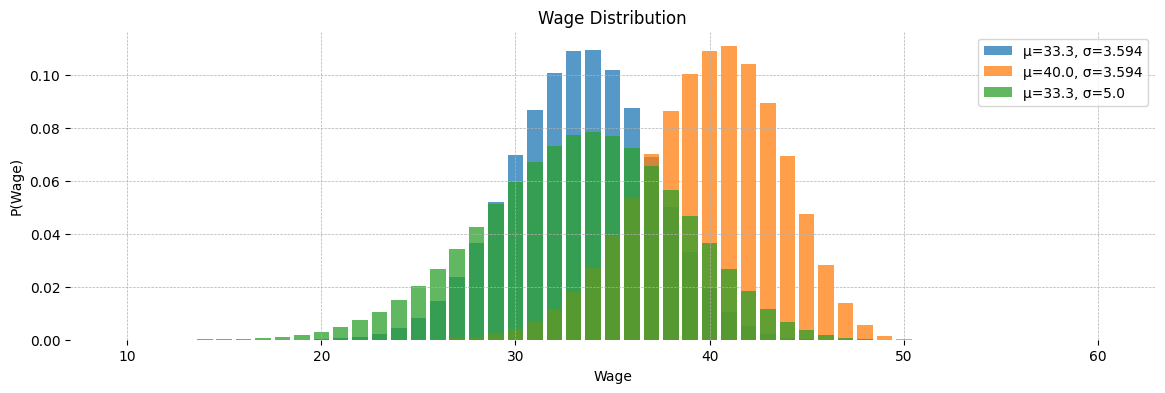
Nice! Now let’s vectorize w_bar over \(\mu\) and \(\sigma^2\), and make a contour plot with vector field
mu_grid, sigma_grid = pt.dmatrices('mu_grid', 'sigma_grid')
w_bar_dist_grads = pt.grad(w_bar_2, [mu, sigma])
w_bar_grid, *w_grad_grid = vectorize_graph([w_bar_2, *w_bar_dist_grads], {mu:mu_grid, sigma:sigma_grid})
---------------------------------------------------------------------------
TypeError Traceback (most recent call last)
Cell In[47], line 2
1 mu_grid, sigma_grid = pt.dmatrices('mu_grid', 'sigma_grid')
----> 2 w_bar_dist_grads = pt.grad(w_bar_2, [mu, sigma])
4 w_bar_grid, *w_grad_grid = vectorize_graph([w_bar_2, *w_bar_dist_grads], {mu:mu_grid, sigma:sigma_grid})
File ~/Documents/pytensor/pytensor/gradient.py:747, in grad(cost, wrt, consider_constant, disconnected_inputs, add_names, known_grads, return_disconnected, null_gradients)
744 if hasattr(g.type, "dtype"):
745 assert g.type.dtype in pytensor.tensor.type.float_dtypes
--> 747 _rval: Sequence[Variable] = _populate_grad_dict(
748 var_to_app_to_idx, grad_dict, _wrt, cost_name
749 )
751 rval: MutableSequence[Variable | None] = list(_rval)
753 for i in range(len(_rval)):
File ~/Documents/pytensor/pytensor/gradient.py:1541, in _populate_grad_dict(var_to_app_to_idx, grad_dict, wrt, cost_name)
1538 # end if cache miss
1539 return grad_dict[var]
-> 1541 rval = [access_grad_cache(elem) for elem in wrt]
1543 return rval
File ~/Documents/pytensor/pytensor/gradient.py:1496, in _populate_grad_dict.<locals>.access_grad_cache(var)
1494 for node in node_to_idx:
1495 for idx in node_to_idx[node]:
-> 1496 term = access_term_cache(node)[idx]
1498 if not isinstance(term, Variable):
1499 raise TypeError(
1500 f"{node.op}.grad returned {type(term)}, expected"
1501 " Variable instance."
1502 )
File ~/Documents/pytensor/pytensor/gradient.py:1171, in _populate_grad_dict.<locals>.access_term_cache(node)
1168 if node not in term_dict:
1169 inputs = node.inputs
-> 1171 output_grads = [access_grad_cache(var) for var in node.outputs]
1173 # list of bools indicating if each output is connected to the cost
1174 outputs_connected = [
1175 not isinstance(g.type, DisconnectedType) for g in output_grads
1176 ]
File ~/Documents/pytensor/pytensor/gradient.py:1496, in _populate_grad_dict.<locals>.access_grad_cache(var)
1494 for node in node_to_idx:
1495 for idx in node_to_idx[node]:
-> 1496 term = access_term_cache(node)[idx]
1498 if not isinstance(term, Variable):
1499 raise TypeError(
1500 f"{node.op}.grad returned {type(term)}, expected"
1501 " Variable instance."
1502 )
File ~/Documents/pytensor/pytensor/gradient.py:1171, in _populate_grad_dict.<locals>.access_term_cache(node)
1168 if node not in term_dict:
1169 inputs = node.inputs
-> 1171 output_grads = [access_grad_cache(var) for var in node.outputs]
1173 # list of bools indicating if each output is connected to the cost
1174 outputs_connected = [
1175 not isinstance(g.type, DisconnectedType) for g in output_grads
1176 ]
[... skipping similar frames: _populate_grad_dict.<locals>.access_grad_cache at line 1496 (9 times), _populate_grad_dict.<locals>.access_term_cache at line 1171 (8 times)]
File ~/Documents/pytensor/pytensor/gradient.py:1171, in _populate_grad_dict.<locals>.access_term_cache(node)
1168 if node not in term_dict:
1169 inputs = node.inputs
-> 1171 output_grads = [access_grad_cache(var) for var in node.outputs]
1173 # list of bools indicating if each output is connected to the cost
1174 outputs_connected = [
1175 not isinstance(g.type, DisconnectedType) for g in output_grads
1176 ]
File ~/Documents/pytensor/pytensor/gradient.py:1496, in _populate_grad_dict.<locals>.access_grad_cache(var)
1494 for node in node_to_idx:
1495 for idx in node_to_idx[node]:
-> 1496 term = access_term_cache(node)[idx]
1498 if not isinstance(term, Variable):
1499 raise TypeError(
1500 f"{node.op}.grad returned {type(term)}, expected"
1501 " Variable instance."
1502 )
File ~/Documents/pytensor/pytensor/gradient.py:1326, in _populate_grad_dict.<locals>.access_term_cache(node)
1318 if o_shape != g_shape:
1319 raise ValueError(
1320 "Got a gradient of shape "
1321 + str(o_shape)
1322 + " on an output of shape "
1323 + str(g_shape)
1324 )
-> 1326 input_grads = node.op.L_op(inputs, node.outputs, new_output_grads)
1328 if input_grads is None:
1329 raise TypeError(
1330 f"{node.op}.grad returned NoneType, expected iterable."
1331 )
File ~/Documents/pytensor/pytensor/tensor/optimize.py:915, in RootOp.L_op(self, inputs, outputs, output_grads)
906 df_dx = (
907 jacobian(inner_fx, inner_x, vectorize=True)
908 if not self.jac
909 else self.fgraph.outputs[1]
910 )
911 df_dtheta_columns = jacobian(
912 inner_fx, inner_args, disconnected_inputs="ignore", vectorize=True
913 )
--> 915 grad_wrt_args = implict_optimization_grads(
916 df_dx=df_dx,
917 df_dtheta_columns=df_dtheta_columns,
918 args=args,
919 x_star=x_star,
920 output_grad=output_grad,
921 fgraph=self.fgraph,
922 )
924 return [zeros_like(x), *grad_wrt_args]
File ~/Documents/pytensor/pytensor/tensor/optimize.py:333, in implict_optimization_grads(df_dx, df_dtheta_columns, args, x_star, output_grad, fgraph)
290 r"""
291 Compute gradients of an optimization problem with respect to its parameters.
292
(...)
329 The function graph that contains the inputs and outputs of the optimization problem.
330 """
331 df_dx = cast(TensorVariable, df_dx)
--> 333 df_dtheta = concatenate(
334 [
335 atleast_2d(jac_col, left=False)
336 for jac_col in cast(list[TensorVariable], df_dtheta_columns)
337 ],
338 axis=-1,
339 )
341 replace = dict(zip(fgraph.inputs, (x_star, *args), strict=True))
343 df_dx_star, df_dtheta_star = cast(
344 list[TensorVariable],
345 graph_replace([atleast_2d(df_dx), df_dtheta], replace=replace),
346 )
File ~/Documents/pytensor/pytensor/tensor/basic.py:2991, in concatenate(tensor_list, axis)
2984 if not isinstance(tensor_list, tuple | list):
2985 raise TypeError(
2986 "The 'tensors' argument must be either a tuple "
2987 "or a list, make sure you did not forget () or [] around "
2988 "arguments of concatenate.",
2989 tensor_list,
2990 )
-> 2991 return join(axis, *tensor_list)
File ~/Documents/pytensor/pytensor/tensor/basic.py:2805, in join(axis, *tensors_list)
2803 return tensors_list[0]
2804 else:
-> 2805 return _join(axis, *tensors_list)
File ~/Documents/pytensor/pytensor/graph/op.py:293, in Op.__call__(self, name, return_list, *inputs, **kwargs)
249 def __call__(
250 self, *inputs: Any, name=None, return_list=False, **kwargs
251 ) -> Variable | list[Variable]:
252 r"""Construct an `Apply` node using :meth:`Op.make_node` and return its outputs.
253
254 This method is just a wrapper around :meth:`Op.make_node`.
(...)
291
292 """
--> 293 node = self.make_node(*inputs, **kwargs)
294 if name is not None:
295 if len(node.outputs) == 1:
File ~/Documents/pytensor/pytensor/tensor/basic.py:2498, in Join.make_node(self, axis, *tensors)
2495 ndim = tensors[0].type.ndim
2497 if not builtins.all(x.ndim == ndim for x in tensors):
-> 2498 raise TypeError(
2499 "Only tensors with the same number of dimensions can be joined. "
2500 f"Input ndims were: {[x.ndim for x in tensors]}"
2501 )
2503 try:
2504 static_axis = int(get_scalar_constant_value(axis))
TypeError: Only tensors with the same number of dimensions can be joined. Input ndims were: [3, 2, 2, 2]
fn_w_bar_dist = pytensor.function([v0, c, β, mu_grid, sigma_grid, n, w_min, w_max],
[w_bar_grid, *w_grad_grid])
---------------------------------------------------------------------------
NameError Traceback (most recent call last)
Cell In[48], line 2
1 fn_w_bar_dist = pytensor.function([v0, c, β, mu_grid, sigma_grid, n, w_min, w_max],
----> 2 [w_bar_grid, *w_grad_grid])
NameError: name 'w_bar_grid' is not defined
mu_values = np.linspace(15, 35, 30)
sigma_values = np.linspace(2.5, 10, 30)
mm, ss = np.meshgrid(mu_values, sigma_values)
w_bars, mu_grads, sigma_grads = fn_w_bar_dist(v0_value, c=25, β=0.99, mu_grid=mm, sigma_grid=ss,
n=50, w_min=10, w_max=60)
From this last plot, we can see the effects of varying the mean (x-axis) and standard deviation (y-axis) of the wage distribution. Since we have access to the gradients, we can also see how the reservation wage changes at each grid point.
Perhaps unsurprisingly, as the mean wage increases, the reservation wage increases. The effect of variance, on the other hand, is revealed to be more complex. When the mean is low, the reservation wage is strictly decreasing in variance. But as the mean increases, there are “sweet spots” in variance, above and below which the reservation wage decreases.
fig, ax = plt.subplots(figsize=(8, 5))
cs1 = ax.contourf(mm, ss, w_bars, alpha=0.75)
ax.quiver(mm, ss, mu_grads, sigma_grads)
plt.colorbar(cs1, ax=ax)
ax.set_title("reservation wage")
ax.set_xlabel(r"$\mu$", fontsize=16)
ax.set_ylabel(r"$\sigma^2$", fontsize=16)
ax.ticklabel_format(useOffset=False)
plt.show()
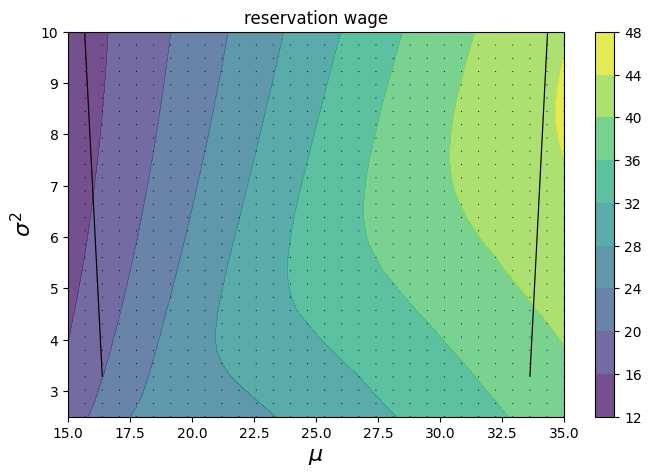
Conclusion#
Anyway, the key point is not the result of the analysis. Instead, we see how we can leverage the power of pytensor’s symbolic graph manipulation to:
Solve a root-finding problem
Compute quantities of interest that depend on the solution
Use graph transformations, including
graph_replace,vectorize_graph, andgrad, to push the analysis even further
References#
Watermark#
%load_ext watermark
%watermark -n -u -v -iv -w -p pytensor
Last updated: Mon Jul 28 2025
Python implementation: CPython
Python version : 3.12.8
IPython version : 8.31.0
pytensor: 2.31.3+5.gacd921952
sys : 3.12.8 | packaged by conda-forge | (main, Dec 5 2024, 14:24:40) [GCC 13.3.0]
numpy : 2.3.1
matplotlib: 3.10.3
pytensor : 2.31.3+5.gacd921952
Watermark: 2.5.0